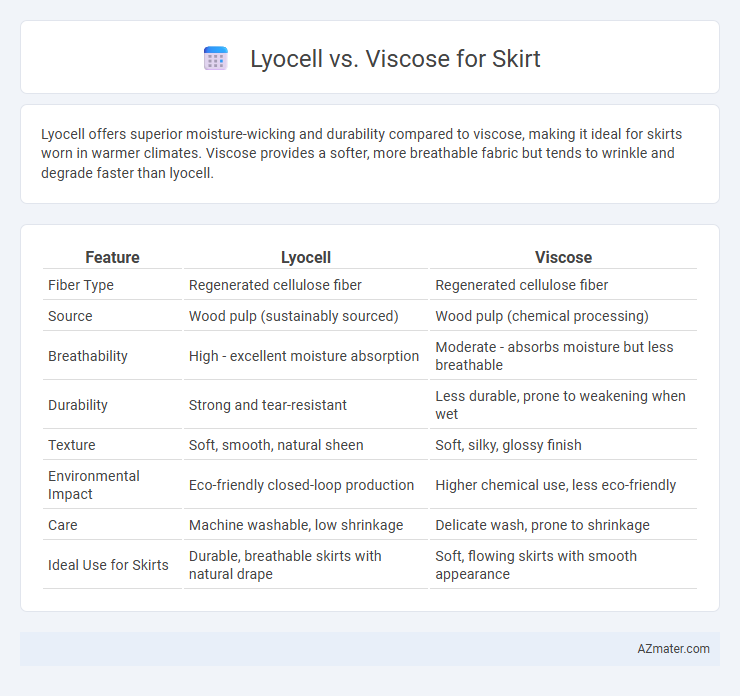Lyocell offers superior moisture-wicking and durability compared to viscose, making it ideal for skirts worn in warmer climates. Viscose provides a softer, more breathable fabric but tends to wrinkle and degrade faster than lyocell.
Table of Comparison
| Feature | Lyocell | Viscose |
|---|---|---|
| Fiber Type | Regenerated cellulose fiber | Regenerated cellulose fiber |
| Source | Wood pulp (sustainably sourced) | Wood pulp (chemical processing) |
| Breathability | High - excellent moisture absorption | Moderate - absorbs moisture but less breathable |
| Durability | Strong and tear-resistant | Less durable, prone to weakening when wet |
| Texture | Soft, smooth, natural sheen | Soft, silky, glossy finish |
| Environmental Impact | Eco-friendly closed-loop production | Higher chemical use, less eco-friendly |
| Care | Machine washable, low shrinkage | Delicate wash, prone to shrinkage |
| Ideal Use for Skirts | Durable, breathable skirts with natural drape | Soft, flowing skirts with smooth appearance |
Overview: Lyocell vs Viscose
Lyocell and viscose are popular fabric choices for skirts due to their soft texture and breathability. Lyocell, made from sustainably sourced wood pulp, offers superior moisture-wicking properties and durability compared to viscose, which is produced through chemical-intensive processes and tends to be less resilient. Both fabrics drape well, but lyocell provides a more eco-friendly option with enhanced strength and shape retention.
What is Lyocell?
Lyocell is a sustainable fabric made from cellulose found in wood pulp, primarily sourced from eucalyptus trees, using an eco-friendly closed-loop production process that recycles water and solvents. It is known for its breathability, softness, and moisture-wicking properties, making it an excellent choice for skirts that require comfort and durability. Compared to viscose, lyocell offers better environmental benefits due to less chemical usage and higher biodegradability.
What is Viscose?
Viscose is a semi-synthetic fiber made from regenerated cellulose derived from wood pulp, often used in skirts for its soft feel and drapability. It offers a smooth texture and excellent breathability, making it comfortable for warm weather, but it tends to wrinkle easily and may lose strength when wet. Compared to lyocell, viscose is less environmentally friendly due to its chemically intensive production process and lower durability.
Production Process Comparison
Lyocell production involves a closed-loop process using non-toxic solvents, making it environmentally friendly and sustainable, whereas viscose production relies on chemical-intensive methods with hazardous byproducts like carbon disulfide. Lyocell fibers are regenerated from wood pulp through direct solvent spinning, minimizing waste and emissions, while viscose fibers undergo chemical treatments that generate significant pollution. The eco-conscious production of lyocell results in stronger, more durable fibers suitable for skirts, contrasting with viscose's softer but less sustainable manufacturing footprint.
Environmental Impact: Lyocell vs Viscose
Lyocell is produced using a closed-loop process that recycles water and solvents, significantly reducing environmental pollution compared to viscose, which relies on toxic chemicals like carbon disulfide and generates hazardous waste. The sustainable production of lyocell results in lower water consumption and fewer greenhouse gas emissions, making it a more eco-friendly option for skirts. In contrast, viscose manufacture contributes to deforestation and soil degradation due to its reliance on wood pulp from unsustainable sources.
Texture and Comfort Differences
Lyocell skirts offer a smooth, silky texture with excellent breathability and moisture-wicking properties, making them highly comfortable for all-day wear. Viscose skirts often have a softer, more plush feel but tend to retain moisture, which may reduce comfort in warmer climates. The natural fiber content in Lyocell enhances durability and skin-friendliness, whereas viscose, being semi-synthetic, can sometimes feel heavier and less breathable.
Durability and Care Instructions
Lyocell skirts offer superior durability due to their tightly bonded fibers, resisting wear and tear better than viscose, which tends to weaken when wet. Lyocell requires gentle washing in cold water and air drying to maintain fabric integrity, while viscose demands even more delicate care, often needing dry cleaning or hand washing to prevent shrinking and deformation. Both fabrics benefit from avoiding high heat during ironing, but lyocell's resilience makes it more suitable for everyday skirt wear with less frequent maintenance.
Breathability and Moisture Wicking
Lyocell fibers offer superior breathability and moisture-wicking properties compared to viscose, making them ideal for skirts that require comfort in warm or humid conditions. Lyocell's structure allows for efficient air circulation and rapid moisture absorption, reducing sweat accumulation and enhancing wearability throughout the day. Viscose, while breathable, tends to retain more moisture and dries slower, which can lead to discomfort during prolonged wear.
Price and Availability for Skirts
Lyocell skirts generally cost more than viscose skirts due to the environmentally friendly production process and sustainable sourcing of lyocell fibers. Viscose skirts are widely available at lower prices, making them a popular choice for budget-conscious consumers. Retailers and fashion brands often stock viscose skirts in a broader range of styles and price points, while lyocell skirts tend to be found in premium or eco-friendly collections.
Which is Better for Skirts: Lyocell or Viscose?
Lyocell is better for skirts due to its superior moisture-wicking properties, durability, and eco-friendly production process compared to viscose. While viscose offers a soft feel and vibrant drape, it often lacks tensile strength and can wrinkle easily, making lyocell a more practical choice for long-lasting, breathable skirts. Lyocell's biodegradability and lower environmental impact enhance its appeal for sustainable fashion enthusiasts.

Infographic: Lyocell vs Viscose for Skirt
 azmater.com
azmater.com